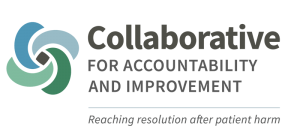Tools and Resources[ Show all or clear results ]
Responding to large scale adverse events
Learning Community
Resources associated with CAI Learning CommunityPresentation/Webinar
Recorded webinars and presentationsTool/Toolkit
CRP resource or tool (e.g. CANDOR)Video
CRP related video, movieCAI Webinar: Large Scale Implementation of Communication and Resolution Programs
Resources associated with CAI Learning Community
Recorded webinars and presentations
CRP resource or tool (e.g. CANDOR)
CRP related video, movie
Large Scale Implementation of Communication and Resolution Programs
Presented by: Heather Gocke, M.S., RNC-OB, CPHRM, C-EFM
Webinar Date: January 29, 2020
Ms. Gocke introduces a comprehensive program and a holistic approach in reducing harm in healthcare through large scale implementation of CRP. In her presentation, she highlights the importance of disclosure and engagement, and she shares real-life challenges and secrets to success.
Learning Objectives:
- Outline the method used to engage member sites in culture transformation
- Learn how culture measurement, survey data debriefs, and cognitive interviewing techniques are used to inform this body of work
- Introduce the five domains and components of BETA HEART
Learning Community
Resources associated with CAI Learning CommunityPresentation/Webinar
Recorded webinars and presentationsVideo
CRP related video, movieCAI Webinar: Responding to Large Scale Adverse Events
Resources associated with CAI Learning Community
Recorded webinars and presentations
CRP related video, movie
Webinar presented by Dr. Tom Gallagher on Thursday, June 6, 2019
Large-scale adverse events, situations in which a breakdown in care has affected multiple (sometimes thousands) of patients, pose significant challenges for institutions related to responding in ways that inform potentially affected patients without unduly alarming them and managing the follow-up. This webinar will highlight lessons learned from the field around responding effectively to adverse events, as well as key unanswered questions.
Learning objectives:
- Describe the diversity of large-scale adverse events, and how responding to these events differs from managing adverse events that affect individual patients
- List the key elements of an effective response to a large-scale adverse events and the tools that are currently available to assist with this process
- Critique an actual large-scale adverse event patient notification letter and press release, and articulate opportunities for improvement in these documents.
Learning Community
Resources associated with CAI Learning CommunityPresentation/Webinar
Recorded webinars and presentationsTool/Toolkit
CRP resource or tool (e.g. CANDOR)Video
CRP related video, movieCAI Webinar: Torts 101
Resources associated with CAI Learning Community
Recorded webinars and presentations
CRP resource or tool (e.g. CANDOR)
CRP related video, movie
WEBINAR DATE: July 16, 2020
This webinar outlines the concerns and questions about the collision between the judicial system and its pathway to addressing medical error and CRP programs.
PRESENTERS: Cindy Jacobs, RN, JD
OBJECTIVES:
1. Describe the basics of how the tort system operates in a medical error/adverse outcome situations
2. Describe the basics and how, when, and why CRP “apology laws,” “mandatory disclosure” laws/requirements, and healthcare licensing systems intersect and/or collide with the tort system
3. Identify key points to assist healthcare professionals in navigating intersections and collisions
Journal Article
Published articles related to CRPDisclosing Adverse Events to Patients: International Norms and Trends
Published articles related to CRP
Researchers reviewed patterns in healthcare policies and trends in five countries (the United States, the United Kingdom, New Zealand, Australia, and Canada) with histories of disclosing adverse incidents to patients. The researchers wanted to analyze the barriers that prevent healthcare providers and institutions from disclosing adverse events to their patients. They concluded that some barriers included difficulties with liability fees, patients’ beliefs on safety in the healthcare setting, and implementing policy changes on a large-scale. Effective ways to combat these challenges include carrying out a long-term program that involves educating patients and healthcare workers about safety.
Tool/Toolkit
CRP resource or tool (e.g. CANDOR)Patient Notification Toolkit (CDC)
CRP resource or tool (e.g. CANDOR)
A Guide to Assist Health Departments and Healthcare Facilities with Conducting a Patient Notification Following Identification of an Infection Control Lapse or Disease Transmission
Journal Article
Published articles related to CRPPatients’ experiences with disclosure of a large-scale adverse event.
Published articles related to CRP
This article discusses the importance for healthcare organizations to understand the patient’s perspective after they received disclosure following an adverse medical event, because it could help them develop more effective communication methods. Researchers found that patients preferred it when healthcare systems disclosed adverse events to them. They also found that these systems should implement policies that promote disclosure between patients and physicians.
Journal Article
Published articles related to CRPThe Disclosure Dilemma — Large-Scale Adverse Events
Published articles related to CRP
Large-scale adverse events are individual events or a series of related events that injured or increased the risk that many patients would be injured because of health care management. There are ethical reasons why institutions may hesitate to disclose large-scale adverse events to patients. Practical, legal, and financial considerations, such as the difficulty in predicting the likelihood of harm and identifying the injured patients, may also lead well-meaning institutions to consider not disclosing large-scale adverse events. This article discusses two ethical frameworks often used in determining whether to disclose large-scale adverse events: utilitarian and duty-based. It also describes three examples of large-scale adverse events and discuss their distinguishing features.
